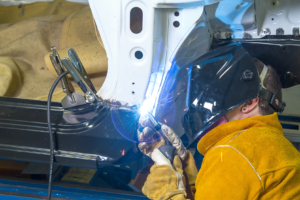Whether you are repairing a bus or the latest high-performance car, a medium or heavy truck, the construction of that vehicle probably looks different from its counterpart from 20 or even five years ago. The materials used to build the frame have moved from the mild steel we all know to new construction like High-Strength Steel, Ultra-High Strength Steel, Aluminum and more to come. Thanks to the influx of new materials that require less heat, GMA MAG (Metal Active Gas, commonly referred as MIG) welding has become the automotive industry standard for repairs.

How can you make sure you and your staff have the skills and knowledge to perform those repairs? Organizations like I-CAR and equipment providers provide training for technicians to understand how welding has changed with the introduction of new materials. Brian Wasson, Welding Program Manager at I-CAR, recently presented ‘What’s New in Heavy Duty Welding’ at the HD Forum in Fort Worth, TX. We will cover the topics he discussed over the next few months.
The first key to a proper frame repair is knowing what you are repairing. Make sure you identify the material accurately before starting the repair. That information will help select the right tools and settings on your welder to ensure the best repair possible. These include:
- Environment preparation
- Welder selection
- Electrode wire selection
- Welder settings
- Surface preparation
- Test weld verification
Once your materials are identified and your preparation is complete, you can move on to the welding process. We will discuss that next month.
